While the mother and baby are still in the maternity hospital, neonatologists regularly weigh the newborn and inform her about changes in his weight. Then, when you are discharged home and make a scheduled visit to your local pediatrician, the baby will be weighed and its height measured, comparing the baby’s indicators with WHO standards. What are the consequences of a deviation from the norm for the development of a newborn, and how to correct these parameters with the help of nutrition?
Table of norms for weight gain and height
Since the 70s of the last century, all developed countries have used reference indicators adopted by WHO to assess the normal development of newborn children. They indicated how much a newborn should weigh at different stages of his life and what the rate of weight gain and height was by month. However, it was believed that the data provided in these recommendations was not entirely correct. Therefore, for almost 30 years, statistics on the development of almost 10 thousand children from countries with different climates and economic levels were collected.
In their research, researchers paid attention to the parameters of the ratio of body length and body weight, throughout the entire period studying how much babies weigh at birth, what is the increase in height and weight gain by month. These indicators were collected from the children studied before they reached the age of 5 years. Based on this truly meticulous work of WHO members, a table of norms for weight gain and height of children was created. It was published in 2006 and categorizes data by gender because girls and boys develop slightly differently.
The development of any baby is assessed using this table. The pediatrician will measure your newborn's length and weight at each appointment, compare it with the data from the previous weighing, and evaluate how the weight turned out over the period. The doctor will definitely compare how much a baby should weigh according to WHO statistics. If there is a discrepancy, the doctor will tell you how to adjust the diet and volume of food if your baby’s weight is far from normal.
What are the norms for weight gain and growth of a baby?
Fortunately, it has not yet been standardized exactly how much a baby should weigh at birth, or what the baby's body length should be. The average height of a newborn ranges from 46 to 56 cm, and the average weight is considered to be between 2.6 and 4 kilograms. For large children weighing more than 4 kg, experts pay close attention, since such a large mass may be a sign of disorders in the body. Doctors take the same seriously to infants born with a weight below normal.
The body length of newborns is usually correlated with their weight. Based on the values obtained from the measurements, pediatricians assess whether children are developing according to WHO standards. In case of lack of weight, doctors recommend how much to increase the amount of food consumed; in case of “ahead of schedule”, they will advise reducing the amount of milk in order to stop too rapid weight gain. As a rule, measures involving changes in food volumes are sufficient for adjustment. If they do not change the situation, and the pediatrician suspects some diseases, he will prescribe the necessary tests to diagnose them.
- In the first month of life, a baby begins the difficult process of adaptation to a new environment. After birth, he loses a little weight, but, having got used to food, he gradually gains it. Regardless of how much the scales in the maternity unit show after the birth of the baby, by the end of the first month of life the baby will have “plumped up” by 600 grams and will have grown an average of 3 centimeters.
- In the second and third months, the baby’s body already gets used to digesting mother’s milk or formula and, due to this, continues to actively grow. The length of his body will increase by 3 cm during each period, and his weight will increase by as much as 800 grams. Along with the body, the head circumference also grows - by 1.5 centimeters every month. By the end of the first trimester of a baby’s life, the amount of milk he consumes doubles, since an actively growing and developing body requires a lot of nutrients and energy.
- further, the baby’s growth and weight gain, according to WHO statistics, slow down slightly. But, nevertheless, on average, newborns gain 750 grams in the fourth month of life, 700 grams in the fifth, and body length increases by 2.5 and 2 cm, respectively. At the end of this period, the baby should weigh twice as much as the figure indicated on his tags from the maternity hospital.
- during the sixth, seventh and eighth months of life, the child becomes heavier by 650, 600 and 550 grams, respectively. This time for the baby is full of pleasant discoveries of the capabilities of his body - he begins to crawl and sit up on his own. Mother's milk is no longer enough to replenish strength, and mothers, on the recommendations of the pediatrician, begin to introduce fruits, vegetables and cereals into their children's complementary foods. The number of feedings per day is reduced from 6 to 5, but the volume of food is now 180 grams. Every month of this interesting and important period of his life, the baby grows 2 cm.
- the child's growth rate gradually slows down, and now the baby grows by 1.5 centimeters per month. The portion size now increases to 250 grams per feeding, and with it the baby’s weight. In the ninth month he will add 500 grams, in the tenth - 450, and in the eleventh - 400.
- By the first birthday, the baby, as a rule, triples its original weight, and in general should grow by 25 centimeters. This is a colossal leap that required great strength and energy from the body. The once tiny, wrinkled baby has now turned into a strong child, eating human food instead of milk - mashed potatoes, steamed cutlets and soups.
As you can see, the height and weight of a child up to a year are actively increasing, with significant increases occurring every month. Your pediatrician will tell you how much your newborn weighs at your appointment, and he will also tell you how much an average baby should weigh according to WHO.
What if the baby’s data is far from WHO standards?
Before you start worrying about the fact that your baby is not up to or exceeds the standards indicated by the WHO table, think about how tall your family members are. After all, if there are no serious pathologies - and, as a rule, specialists see them immediately - then remember that the height and weight of children are harmoniously correlated.
If the baby eats well, but his measurements and weighings are less than standard, then most likely he is just small and should be the same size as someone close to him who is short. In most cases, this also explains the slight “excess” of length and weight. Often, too active weight gain in children who begin to crawl after six months is reduced to standard values, and they ultimately weigh as much as the WHO table indicates in the normal line.
Don't be afraid of discrepancies with statistics - these are just numbers. Each child is an individual, with his own characteristics of growth and development, which cannot be confined to the strict framework of tables. If you see that your baby is active and cheerful, then everything is fine with him. And your local pediatrician will tell you how best to correct underweight or excess weight, if he considers these measures necessary.
| Age | Body weight in (g) | Weight gain per month in (g) | Body length in (cm) | Height gain per month in (cm) |
|---|---|---|---|---|
| Newborn | 3100-3400 | - | 50-51 | - |
| 1 month | 3700-4100 | 600 | 54-55 | 3 |
| 2 month | 4500-4900 | 800 | 55-59 | 3 |
| 3 month | 5200-5600 | 800 | 60-62 | 2,5 |
| 4 month | 5900-6300 | 750 | 62-65 | 2,5 |
| 5 month | 6500-6800 | 700 | 64-68 | 2 |
| 6 month | 7100-7400 | 650 | 66-70 | 2 |
| 7 month | 7600-8100 | 600 | 68-72 | 2 |
| 8 month | 8100-8500 | 550 | 69-74 | 2 |
| 9 month | 8600-9000 | 500 | 70-75 | 1,5 |
| 10 month | 9100-9500 | 450 | 71-76 | 1,5 |
| 11 month | 9500-10000 | 400 | 72-78 | 1,5 |
| 12 month | 10000-10800 | 300 | 74-80 | 1,5 |
The baby was born, and overjoyed relatives excitedly discuss whether the child’s weight and height correspond to the norms. Normal indicators are considered to be a newborn’s weight from 2,600 to 4,000 grams and height between 45-56 centimeters. However, doctors evaluate not only these numbers; what is more important for them is the ratio of these parameters, which is determined by the so-called Quetelet index.
To do this, the child’s weight at birth must be divided by his height, the resulting number will be the desired value. For example, if the baby’s mass of 3,500 grams is divided by the child’s height of 52 centimeters, then the Quetelet index will be equal to 66, and its permissible values are in the range of 60-70. However, this is only true for those born on time; for premature babies the indicators will be different. However, below in the article we will consider all aspects that influence the relationship between the height and weight of a child at each stage of his development. And also, using a special table, you can quickly determine whether your child’s height and weight are normal or if there are deviations.
Height and weight of a child up to one year old
In the first days after birth, the baby loses up to 8% of its original body weight. Experienced moms they know that there is no need to be afraid of this - in 8-10 days the child’s weight will be restored and he will begin to get better. During the first year of life, the child’s weight and height are measured monthly, because from them the doctor will be able to determine how well the baby is eating and developing.
In the first half of the year, the average weight gain is 700-750 grams, then it decreases slightly - every month the child gains 550-350 grams. This is primarily due to physical activity crumbs, which increases after six months. During the first year of life, the child’s weight increases approximately three times and ranges from 8.5 to 12 kilograms. The baby is also growing at a steady pace; by the first birthday, the child’s height increases by about 25 positions, to 71.2-79.7 centimeters.
The dynamics of height and weight gain may vary, as they depend on many factors. Insufficient weight gain may occur:
For prolonged diarrhea;
After infectious diseases or even a common cold;
If you have allergic reactions;
Inadequate nutrition - reduced secretion of mother's milk can cause the baby to be switched to mixed or artificial feeding.
However, the exact reason that the child’s weight does not increase can only be determined by a doctor after an examination. He will also give the necessary recommendations.
Height and weight of a preschool child
You should continue to monitor the weight and height of babies after a year. It is now much easier to do this at home - the child’s height can be easily measured using a special paper stadiometer with centimeter divisions, which is simply glued to a flat wall. The baby should take off his shoes, help him straighten up as much as possible - his shoulder blades, heels and buttocks should touch the wall. An ordinary ruler is applied at a right angle to the stadiometer, and the mother records the child’s height. Its compliance with the average indicators at the specified age can be checked using a special table, the description of which is given below. The child’s weight is measured using electronic scales, in the center of which the restless child can be placed or seated. It is better to carry out the procedure on an empty stomach and after going to the toilet, so the result will be more accurate.
From the third year of life, the baby gains weight on average two kilograms per year, and by the age of seven his weight, compared to the first year of life, doubles. To find out whether a child’s weight is normal, you can calculate it using a simple formula. To do this, to the baby’s body weight at one year, you need to add twice his current age: A + 2B, where A is body weight at one year, B is age, 2 is the annual average weight gain between the ages of 3 and 7 years. If the fidget weighed 9 kg on his first birthday, and now he is 6 years old, then: 9 + 2x6 = 21 kg, that is, normally he should weigh 21 kilograms.
A similar formula helps determine whether the child’s growth corresponds to age indicators: D + 5E, where D is the growth of a one-year-old baby, E is age, 5 is the annual increase in height. For example, a five-year-old boy, whose height at one year old was 75 cm, should now show 75 + 5x5 = 100 centimeters on a stadiometer. Parents should know that their child is not growing at the same rate. Experts note the existence of three periods of “extension”, two of which occur during preschool age- the first year of life, when the increase in height is 25 centimeters, and the age of 5-7 years, when the child’s height increases by 8-10 centimeters.
During periods of intense pulling, the baby requires parental support and attention. He becomes clumsy and awkward, having difficulty adapting to changed parameters and new sensations. At this stage, if the child’s growth does not reach the average, the mother can help him with a special diet, and the father can offer to master the Swedish wall and horizontal bar. Products that stimulate the formation of growth hormone are:
Meat (lean);
Carrot;
Fish dishes;
Dairy products;
Butter;
But it is better to limit sweets; glucose does not contribute to the addition of extra centimeters. The child's weight should also be constantly monitored. If the discrepancies with the average age indicators exceed 20-25% in one direction or another, the mother should consult a pediatrician. Perhaps dietary errors are to blame, or maybe you will need advice from an endocrinologist.
Height and weight of school-age children
On school years the most significant changes in the child’s weight and height occur. Rapid and uneven development, intensive growth, improvement of the muscular system are reflected in the indicators physical development children. From eleven to sixteen years of age is the period of growth spurt, but for some it can be observed from 13 to 15 years, while others begin to grow rapidly at 13-14 years. During this period, the child’s weight may not correspond to his height, since sometimes the muscles do not have time to gain the required mass. Teenage angularity and awkwardness is a completely normal condition and does not require adjustments or special diets.
Parents should remember that many factors influence a child’s growth at school age:
Good nutrition - sufficient and high quality;
Correct work and rest schedule;
Sports activities;
Heredity;
Habitat.
A child's weight during adolescence may be normal indicators and even be somewhat shorter, and children are embarrassed by being overweight. What is the reason? Well-developed muscles weigh four times more than fat. Therefore, a child who does not play sports and has insufficiently developed muscle mass, will look fat. IN in this case regular people can become excellent helpers physical activity and nutritional adjustments.
Child's height and weight - a useful and necessary table
Mothers and fathers of children from 0 to 17 years old can easily determine the height and weight of their own children using a special table. In the top line there are numbers from 1 to 8, which indicate a kind of assessment of physical development indicators, and percentage values specify deviations from average indicators. Light green Columns with normal parameters are highlighted, and white are those that draw the attention of parents to a possible increase in problems.
Child's height and weight chart
If the child's weight and height are in the column colored brown, parents should think about whether it’s time to consult a doctor. There may be some deviations in the development of the child, and appropriate measures should be taken.
The birth of a child is a great happiness and at the same time, a huge responsibility. As a rule, parents have a lot of different questions (especially if this is their first child) regarding upbringing, development and health. In this article we will consider in some detail such an important indicator as the norms of weight and height of children.
Already in the first minutes of life, doctors examine and measure the child’s height and weight. From this touching moment, the history of the baby's development begins. Next, the baby will be weighed upon discharge from the maternity hospital and this procedure will be repeated monthly at an appointment with the pediatrician.
Weight and height are the main anthropometric data about a child’s development. The body length of a newborn depends both on heredity and on the sex of the child, the quality of the mother’s nutrition, etc. The baby’s growth after birth occurs in a certain way: it grows most intensively in the first three months of life, then the increase gradually decreases. Weight is a more dynamic parameter, so it is “tied” to height to determine the harmonious development. Body weight gain in the first months of life is usually greater than in subsequent months and amounts to about 800 g. Then weight gain decreases and depends on factors such as the type of feeding, body characteristics and others.
You can track your child’s height and weight gain in more detail in the tables below.
Average height and weight of a child at birth
Statistics say that newborns weigh 2600–4500 g. Growth parameters range from 45 cm to 55 cm. All this is the norm, but do not worry if your baby is a little smaller or larger, because the norm is only a guideline, not law. It is possible that your child has his own developmental schedule, which will not affect his health in the future.
Approximate height and weight of a child
There are no strict standards for the height and weight of children. In this matter, everything is very individual and depends on many reasons, such as heredity, type of feeding, etc. For example, everyone knows that when breastfeeding The baby develops more harmoniously than with artificial birth. But, nevertheless, there are some guidelines, presented in centile tables, by which doctors determine the correct development of the child. They were developed by the World Health Organization (WHO) in 2006. Before this, such tables were created more than twenty years ago and did not reflect the individual characteristics of content and upbringing, as well as nationality and region of residence. Below you can familiarize yourself with them.
Tables of weight and height norms for children from 0 to 17 years old
Girls
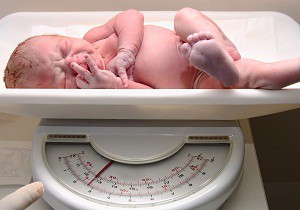
Boys
Intervals that are close to the average are rated as below and above average. Such indicators are considered normal.
Indicators are low (very low) or high (very high) - if your child’s weight or height falls into this zone, it means that his development is different from the norm. In this case, you need to be vigilant and ensure timely examination, receive adequate consultation from specialists and, if necessary, carry out treatment.
One of the reasons for the lag behind weight and height standards in infants is a nutritional deficiency.  Such problems occur in breastfed babies when there is a small amount of breast milk from the mother. In this case, you should stimulate lactation or supplement the baby with dry formula.
Such problems occur in breastfed babies when there is a small amount of breast milk from the mother. In this case, you should stimulate lactation or supplement the baby with dry formula.
We should not forget that excessively intense weight gain also does not have the best effect on the baby’s health. Children with large body weight are less active, begin to walk and crawl somewhat later, and are prone to allergies and long-term illnesses. This is usually observed when artificial feeding, since it is easy to overfeed a child.
By carefully monitoring your baby's development now, you will protect yourself and him from possible problems in the future.
All parents, without exception, worry about the health of their child. The issue of full physical, mental, and neuropsychic development especially worries parents in the first year of the baby’s life. How does a child develop month by month? We offer for consideration an approximate plan for the development of a toddler: we will evaluate the psychophysical development of a child up to one year old, terms and standards according to WHO.
Up to one year, all babies develop approximately the same, but you need to make allowances for individual characteristics and parameters of the child at birthTable of physical parameters up to a year
To assess the rate of growth, weight gain and physical development of the baby, it is worth familiarizing yourself with the average generally accepted indicators of the stages of development of a child up to one year. However, we must not forget that all children have individual development schedules; exact compliance with the given tables is not mandatory; minor deviations from the norms are allowed. Do not forget also that boys and girls differ slightly in their neuropsychic development, but if the baby does not acquire normal skills and development indicators for his age for a long time, it is necessary to consult a doctor.
Table of physiological parameters of a child up to one year:
| Age, months | Height, cm | Weight, kg | Head circumference, cm | Chest circumference, cm |
|---|---|---|---|---|
| 49,0 - 54,0 | 2,6 - 4,0 | 33,0 - 37,0 | 31,0 - 35,9 | |
| 1 | 52,0 - 55,0 | 3,0 - 4,3 | 35,8 - 37,2 | 34,0 - 36,0 |
| 2 | 55,0 - 57,0 | 4,5 - 5,0 | 37,5 - 38,5 | 36,0 - 38,0 |
| 3 | 58,0 - 60,0 | 4,0 - 6,0 | 38,0 - 40,0 | 36,0 - 39,0 |
| 4 | 60,0 - 63,0 | 4,5 - 6,5 | 38,0 - 40,0 | 36,0 - 40,0 |
| 5 | 63,0 - 67,0 | 6,5 - 7,5 | 37,5 - 42,2 | 37,0 - 42,0 |
| 6 | 65,0 - 69,0 | 7,5 - 7,8 | 42,0 - 43,8 | 42,0 - 45,0 |
| 7 | 67,0 - 71,0 | 8,0 - 8,8 | 43,8 - 44,2 | 45,0 - 46,0 |
| 8 | 71,0 - 72,0 | 8,4 - 9,4 | 44,2 - 45,2 | 46,0 - 47,0 |
| 9 | 72,0 - 73,0 | 9,4 - 10,0 | 45,2 - 46,3 | 46,5 - 47,5 |
| 10 | 73,0 - 74,0 | 9,6 - 10,5 | 46,0 - 47,0 | 47,0 - 48,0 |
| 11 | 74,0 - 75,0 | 10,0 - 11,0 | 46,2 - 47,2 | 47,5 - 48,5 |
| 12 | 75,0 - 76,0 | 10,5 - 11,5 | 47,0 - 47,5 | 48,0 - 49,0 |
So, how does a newborn baby grow during the first year? Let's consider the development of a child up to one year using a calendar divided into every 3 months from the birth of the baby.
From birth to 3 months

A newborn is born with developed hearing and vision. There is a clear manifestation of innate reflexes: the child can suck, swallow, blink and grab from the first minutes of life. However, the baby is not yet capable of rolling over. A newborn cannot lift his head from a position on his tummy, but the instinct of self-preservation kicks in - he turns his head onto his cheek.
The baby is able to hold his head for several seconds and tries to lift it when he lies on his tummy. In a month, a response to sounds and sudden movements occurs, expressed in the involuntary spreading of the arms and their subsequent pressing to the body. Spontaneous imitation of walking can also be observed.
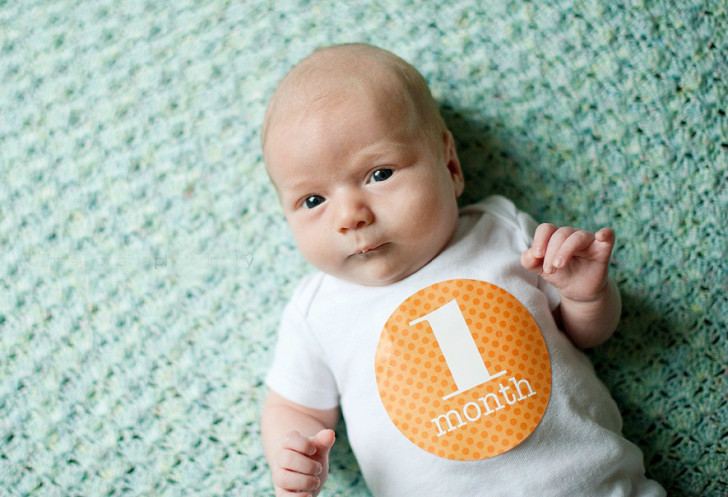
The baby lifts and holds the head “standing” for 1 – 1.5 minutes, and from a position on the tummy, it can lift not only the head, but also the chest. Pays attention to sounds and bright lights by turning his head and looking attentively. There is an intensive development of the vestibular apparatus. The child grabs and holds moving objects.
At 3 months, the baby should hold his head well for 1 to 3 minutes. From a lying position on his stomach he can rise up, leaning on his elbows. He begins to roll over, spin, change position, but there is still no clear coordination in his movements. He watches the toys with interest and reaches out to them. He begins to put his fingers in his mouth, grab and pull the sheet.
I like the company of adults. Communication with parents is very captivating for the baby, the baby “comes to life”, shows joy, smiles, laughs. Can walk for a long time, turns its head towards unfamiliar sounds. Now the baby is especially touching, don’t forget to take photos often as a keepsake!
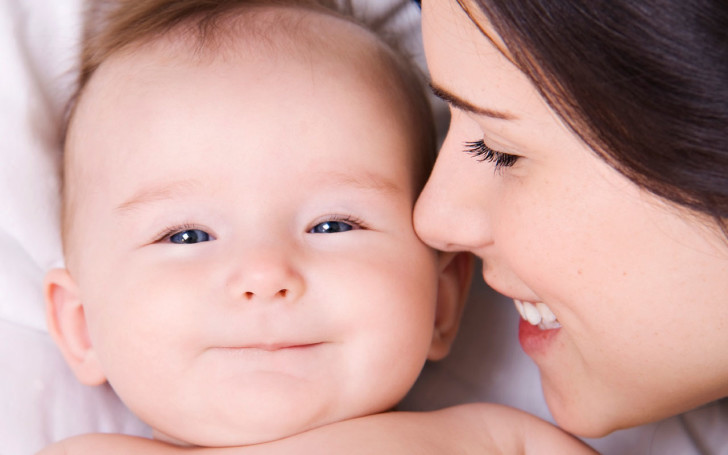 At three months, the baby begins to actively socialize - he becomes more emotional and reacts vividly to other people.
At three months, the baby begins to actively socialize - he becomes more emotional and reacts vividly to other people. Physical Features
| Month | Movements and skills | Vision | Hearing |
|---|---|---|---|
| 1 | Arms and legs are bent, movements are poorly coordinated. Everything is built on unconditioned reflexes. The sucking and grasping reflexes are especially pronounced. By the end of the month he can turn his head. | Can keep a face or toy in sight for several minutes. Can follow with its eyes a toy moving in an arc (so-called “automatic tracking”). | The mucous fluid in the eardrum gradually dissolves, as a result of which hearing improves. The baby listens to the voice and rattle. |
| 2 | Active movements develop: moves the arms to the sides, turns the head. In the prone position, maybe for 5 seconds. raise your head. Hand movements are improved: 2-3 sec. holds the rattle and hits it. | Smoothly follows moving objects for 10-15 seconds. Fixes gaze on the toy/face for 20-25 seconds. Able to perceive objects three-dimensionally. | Focuses on sounds for 5-10 seconds. and turns his head towards the sounds of the rattle and voice. |
| 3 | Within 30 sec. holds the head in the hands of an adult, and during 1 minute – lying on your stomach. In this position, he rises on his arms, leaning on his elbows. When the baby is held under the armpits, he rests his feet on the surface, while his legs are straightened. There is a general motor “revival”: it can bend, become a “bridge” and fall onto the crib. The grasping reflex transforms into a conscious grasp. | Interested (and not automatically) follows a toy moving in an arc. Reviewed for about 5 minutes. your hands. He is interested in all nearby objects (up to 60 cm from the eyes). | “Localization” of sound is formed: first, the child turns his eyes in the direction of the sound, and then turns his head. Begins to react poorly to loud, sharp sounds: freezes, winces and then cries. |

Neuropsychic development
| Month | Emotions | Speech | Intelligence |
|---|---|---|---|
| 1 | By the end of the month, he smiles back at his mother and calms down from the affectionate intonations. He listens to voices and joyfully wiggles his arms and legs in response to loud speech. Gradually, a “revival complex” is formed - a reaction to a loved one. | Pronounces guttural sounds: uh, k-kh, gee. | The second stage of sensorimotor intelligence. The baby adapts to the world around him, interest in objects appears, and coordinated movement of hands and eyes develops. |
| 2 | The child responds with a smile when addressed to him and wiggles his arms and legs. | In communication, the sounds of the initial stage of humming appear: ag-k-kh, k-khkh. The scream takes on different intonations. | Interest in external objects increases, visual orientation reactions improve. |
| 3 | The revival complex manifests itself 100% - this is the first conscious act of behavior, an attempt to interact with an adult “eye to eye.” The revitalization complex marks the beginning of the infancy stage. | Vowel sounds and their different combinations appear: aaa, ae, ay, a-gu. | Interest in the environment becomes selective and conscious. |
From 4 months to six months

While in a supine position, infant raises his head. If you put it on its legs, it rests firmly on them. Starts to sit up and can easily roll over from back to tummy. Freely lifts the body and rests on the palms when lying on the tummy. Carefully observes objects and can grab them. Plays with rattles.
The baby can sit, but still does not hold his back straight; he can stand on his legs if he is held by the arms. Makes first attempts to roll over from tummy to back. Holds an interesting object in his hand for a long time. Recognizes parents, begins to be afraid of strangers. According to Komarovsky, the baby already understands various vocal intonations and begins to distinguish and understand the mother’s emotions.
At this stage, the child can already sit. It holds its back straight and easily rotates in all directions. With a little help from an adult, he can stand on his feet and tries to walk. He begins to get on all fours and move around in this way. Already actively waving toys, picking up fallen objects.
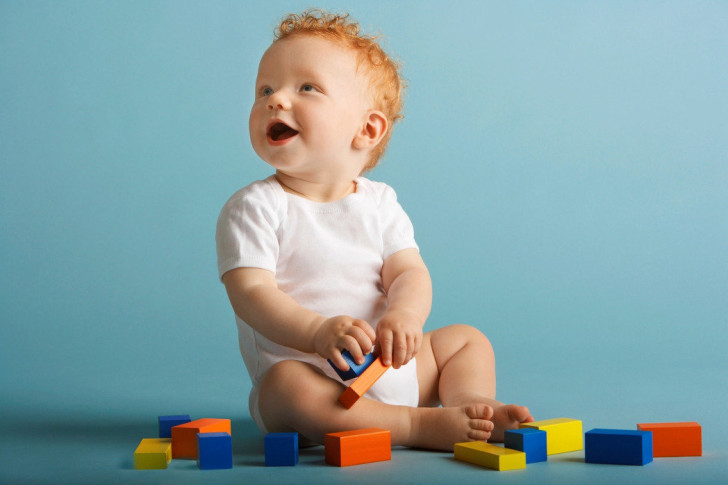
Noticeable changes also occur in speech:
- begins to express the first requests;
- the humming is replaced by simple babbling sounds “ma”, “pa”, “ba”.
Physical Features
| Month | Movements and skills | Vision | Hearing |
|---|---|---|---|
| 4 | He turns on his side and tries to roll over. Holds toys well and pulls them into his mouth. During feeding, he touches the breast or bottle with his hands, trying to hold it. | Recognizes loved ones, smiling back, recognizes himself in the mirror. Watches the toy for about 3 minutes. | Freezes at the sound of music. Clearly turns the head towards the sound source. Distinguishes voices. |
| 5 | While lying on his back, the baby tries to raise his head and shoulders (as if trying to stand up). When lying on his stomach, he rises up, resting his palms on his straight arms. You can sit for a short time, holding onto the support with both hands. He studies objects by touch for a long time and puts them in his mouth. Skills: eats semi-thick food from a spoon, drinks water from a cup. | Distinguishes between close and unfamiliar people. Watches the toy for 10-15 minutes. | Distinguishes the intonations of speakers. Confidently turns his whole body towards the source of the sound. |
| 6 | Rolls over from tummy to back. Practices crawling using hand pull-ups. Sits with support. Stands steadily if an adult supports him under the arms. Confidently reaches and grabs objects, transfers a toy from one hand to another. Can hold a bottle with one or two hands. | Visual acuity develops, very small objects become interesting. | Listens to whispers and other quiet sounds. Sings along to the beat of the music. |
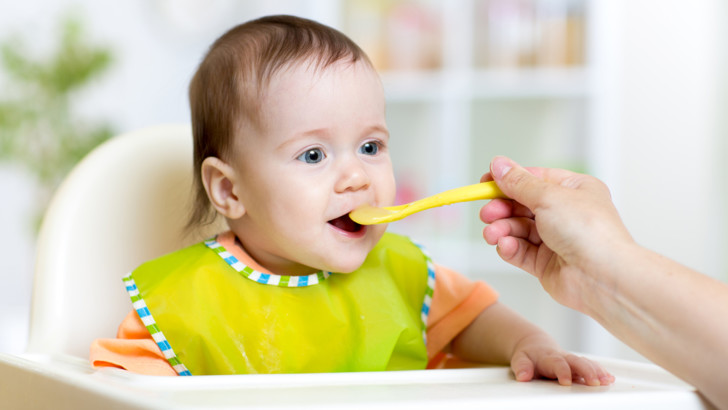 6-7 months - time for the first complementary foods
6-7 months - time for the first complementary foods Neuropsychic development
| Month | Emotions | Speech | Intelligence |
|---|---|---|---|
| 4 | He really laughs and smiles back. Reacts to tickling. Requires attention. | He hums, pronounces chains of vowel sounds, and the first syllables appear. | The 3rd stage of sensorimotor intelligence begins - the implementation of purposeful actions. An understanding of cause-and-effect relationships emerges. A reaction to everything new develops. |
| 5 | Wants to participate in communication - tries to attract attention in every way. “Communicates” with other children with pleasure. | There is a singing hum. Uses vowel sounds: aa, ee, oo, ay, maa, eu, haa, etc. | He is interested not only in close objects, but also in those located at a distance of up to 1 m. He understands that in addition to his hands, he has other body parts. |
| 6 | Begins to experience true love and attachment to the adult raising him. He expects approval and praise from him, thus, communication takes on a situational and business character. | Pronounces individual babbling syllables. IN " vocabulary"already about 30-40 sounds. | Sets goals and chooses means to achieve them. For example, to get one toy, you need to move another. |
From six months to 9 months
The baby can easily and quickly crawl on all fours and sit freely and for a long time. In a sitting position, he straightens and bends. Holding onto furniture, he can kneel down, and with the support of adults he can stand and walk. Interested in his mirror image. Can point with eyes at large objects, called adults.
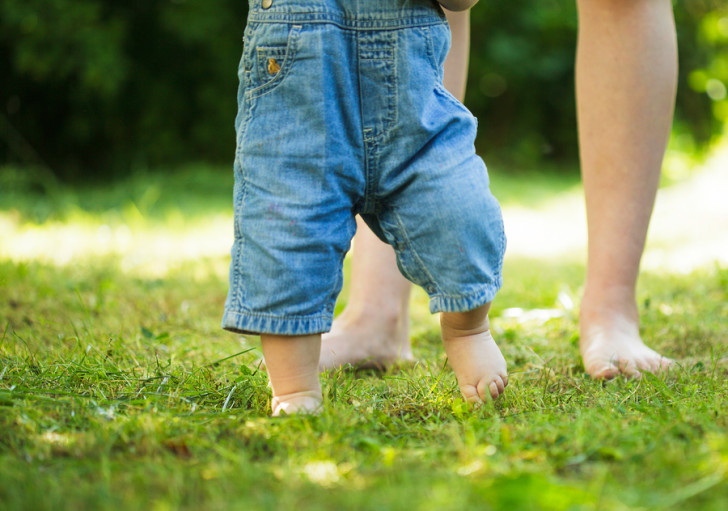
According to the developmental calendar, at 8 months the child can sit down independently and even stand on his feet. He begins to play "palm", imitating clapping his hands. He enjoys trying to take his first steps with the help of adults. Mimic movements of the face acquire a rich variety. The baby expresses interest, surprise, and fear with facial expressions.
He easily finds an object that interests him and persistently tries to reach it. Spends a lot of time playing - he can look at toys for a long time, knock them, throw them.
Standing on his feet, he refuses support. Likes to walk, leaning on furniture, tries to get to his feet from any position. Starts to climb on high places - boxes, benches, pillows. At 9 months, motor skills become more complex, the baby can assemble small parts of toys, sort out construction sets, and move cars.
Understands and can fulfill simple requests, such as “pass the ball” or “wave your hand.” For games he chooses a sitting position, easily and quickly remembers new words. I like to look for dropped or hidden objects. Responds when called by name. Begins to distinguish words not only by intonation, but also by meaning. Can sort objects by shape, color, size.
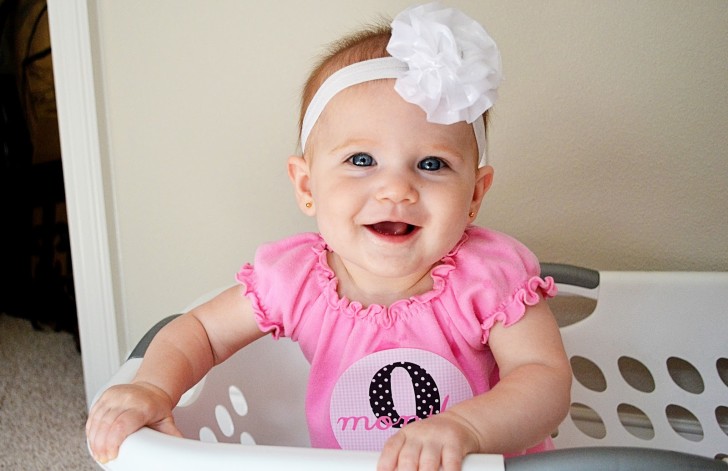 At 9 months the baby is already “very big”, he begins to understand the meaning of many words, fulfills the requests of his parents, the games gradually become more complicated
At 9 months the baby is already “very big”, he begins to understand the meaning of many words, fulfills the requests of his parents, the games gradually become more complicated Physical Features
| Month | Movements | Skills |
|---|---|---|
| 7 | Able to sit without support, roll over from back to stomach and back. Actively crawls on all fours. Favorite action with objects/toys is throwing. He himself reaches for the toy, takes it in his hand, moves it, waves it, knocks it on the surface. | Confidently drinks from a cup (from the hands of an adult), tries to hold it. Eats from a spoon. If the mother gives a dried product or cracker, then the child spends a long time “procrastinating” on this piece. |
| 8 | Rise to his feet independently, holding onto support. With the support of an adult, he steps with his legs. He sits and lies down on his own and crawls a lot. | If he sees “his” cup from an adult, he pulls his hands towards it. He holds a piece of bread in his hand and eats it himself. You can start potty training your baby. |
| 9 | Holding onto a support with one hand, you can do a lot different actions: walk towards an adult with side steps, grab another support with your free hand, etc. Sits confidently for 10-15 minutes. Actively crawling. | Drinks from a cup, holding it (the cup is fixed in the hands of an adult). If a child has begun potty training, he can confidently sit on it without whims. |
Neuropsychic development
| Month | Emotions | Speech | Intelligence |
|---|---|---|---|
| 7 | Tries to be the center of attention. Now caresses and kisses are not the main thing (they may turn away or move away), but the important thing is playing together and manipulating toys. | Actively babbling. Can already pronounce clear syllable combinations: ma-ma, ba-ba-ba, pa-pa-pa, a-la-la, etc. | An understanding of cause-and-effect relationships develops, for example, throwing a toy and seeing where it lands; if he is hungry, he looks towards the kitchen (to where he is fed). |
| 8 | Becomes closed off from strangers (crisis 8 months), ready to communicate only with very close ones, worries and cries in front of others. | Speaks syllables and syllable combinations: ay, a-la-la, he, a-dyat, a-de-de, a-ba-ba, etc. | Stage 4 of sensorimotor intelligence begins: purposeful actions develop. The child studies and explores everything. |
| 9 | Experiences a whole range of emotions from anger and fear to joy and surprise. Strives to communicate with adults and involve them in their activities. | The first indicative words appear in speech, understandable only to those close to you. Understands prohibition words (“you can’t”), teachings (“show me how...”, “kiss mom,” etc.) | The child separates himself from the adult, but perceives himself as the “center of the universe.” Long-term memory develops (can remember an object) and working memory. |
From 10 months to 1 year
After 10 months, the child gets on his feet without help and begins to walk. Begins to step when supported by one handle. Can pick up a small object with his fingers, gets upset when toys he likes are taken away. Often and consciously imitates the movements of adults, can open-close, lift-throw, hide-find. The child pronounces simple monosyllabic words.
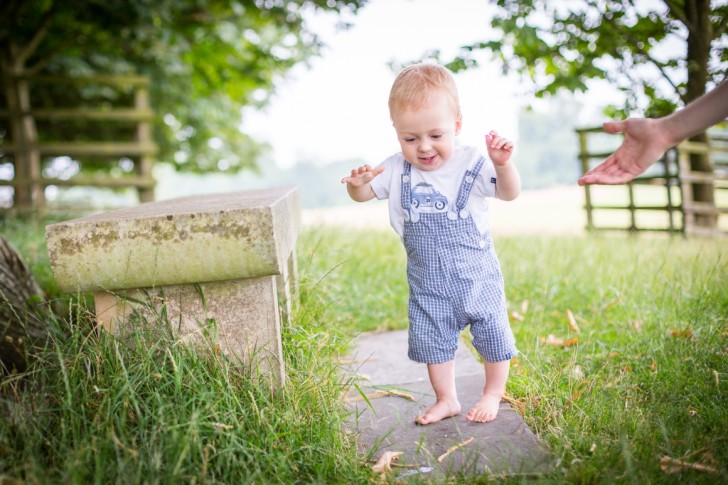
The baby is developing rapidly. Basic movement skills are well developed. Can show many objects (toys, furniture, body parts, animals). Understands and fulfills most simple requests; he expresses reluctance or denial by shaking his head.
The development stage begins fine motor skills fingers, can tear a sheet of paper with two fingers. You should pay great attention to the baby’s curiosity, encourage it and be sure to talk to the child as much as possible.
After 11-12 months, a difficult stage of development begins. Boys often develop a little slower than girls. The ability to walk independently appears. He may come up on his own if his name is called. Able to squat and stand up without support. Picks up objects from the floor without sitting down. Can carry out complex tasks: close doors, bring a toy from another room.
Shows interest in the process of undressing and bathing. Says about ten simple words. At one year old, the child watches people and cars with interest. You can find more detailed information on the Internet by watching Komarovsky’s video about the proper development of children from 0 to one year.
Physical Features
| Month | Movements | Skills |
|---|---|---|
| 10 | Can stand independently for some time without support or support. | |
| 11 | Stands well from a support for about 5 seconds, balancing with his arms, while keeping his legs apart. He tries to take the first steps himself, and with the support of an adult he walks confidently. | All previously acquired skills and abilities are consolidated. |
| 12 | Walks independently (up to 3 meters). Freely squats and rises, bends and picks up an object/toy from the floor. Can climb up the stairs. | Drinks from a cup himself, without adult support. He holds the spoon confidently and moves it around the plate. |
Neuropsychic development
| Month | Emotions | Speech | Intelligence |
|---|---|---|---|
| 10 | The child develops a full-fledged attachment to people who are significant to him. He gets along well with other children. | Repeats individual syllables after adults. Communicates with loved ones in a language that only they understand. Understands the words: “give me...”, “where..?”. | All sensations become qualitatively more complex: hearing, smell, taste, tactile perception. |
| 11 | He treats other children selectively, but in general, he enjoys communicating with them and babbles. May take other people's toys. | Says 1-2 words. Pronounces onomatopoeia, such as “bi-bi”, “av-av”. Can understand and fulfill adult requests (for example, “drive the car”, “feed the doll”). | Learns to manage his actions, mentally organizes all information coming from outside. |
| 12 | Experiences the widest range of emotions, based on the feeling of “separation” from an adult (since he can already move independently). | Repeats syllables after adults. Denotes individual concepts and objects with babbling words. Without showing an object/toy, he understands what is being said. Can carry out instructions such as “show..,” “find...”, “put in place...”, “bring.” | The 5th stage of development of sensorimotor intelligence begins: understands categories of objects and phenomena (for example, animals, furniture, food). Voluntary attention begins to form. |
Doctor Komarovsky's opinion
Dr. Komarovsky, who is popular today, talks clearly and interestingly about children in his book “The Beginning of Life: Your Child from Birth to 1 Year,” as well as in his video lessons. Of course, the main emphasis is on pediatric issues, but in addition, from books and lectures you can learn about:
- principles of caring for toddlers;
- nutrition and feeding of children (according to WHO, as well as according to the author’s complementary feeding methodology);
- key stages of growth and development (when the baby should sit, crawl, stand and walk).
Young parents are interested in how much a newborn should weigh. Excitement occurs if the baby was born weak, with low body weight. Sometimes concerns arise if a strong baby weighing more than 4.5 kg is born.
Pediatricians recommend a table that shows the average weight of a newborn baby. Compare your baby’s indicators with the norm, and you will understand whether the newborn receives enough nutrition, whether the entire volume of breast milk or nutritional formula is fully absorbed. The article identifies factors influencing changes in body weight in children early age.
What affects the weight gain of a newborn

The dynamics of the weight of a tiny person depends on many reasons. Only a pediatrician can decide how optimal the rate of weight gain is after examining the baby, talking with parents, and finding out feeding methods.
Main factors:
- gender of the child. Statistics say: in most cases, boys gain weight faster;
- hereditary predisposition. Parents' complexion, features of body growth childhood at mom and dad's;
- nutritional features of a nursing mother. When the quality of milk deteriorates and an unpleasant aftertaste appears, the newborn sucks weakly at the breast and drinks a smaller volume of nutrient fluid;
- type of feeding. Artificial babies often gain weight more actively due to the content of sugars, fats, and palm oil in cheap milk formulas;
- health of the newborn. Weak children with congenital pathologies, birth injuries, and various diseases gain weight worse;
- feeding regime, free or clearer daily routine. Babies who receive a portion of breast milk “on demand” increase their body weight faster;
- baby's mobility. Energetic, active toddlers spend more energy, weight gain is slightly lower than a couch potato;
- baby's appetite. Each child is an individual. Some babies greedily suck on their mother’s breasts, drink every drop, others lazily, leisurely smack their lips, do not want to strain, and often fall asleep during feeding. It’s easy to guess: in the second case, the child does not always choose the prescribed amount of milk; body weight with inactive absorption of nutrient fluid will be slightly lower;
- age of the toddler. The weight gain of a newborn is not the same in different months. The baby's weight increases most actively from the first to the third month, later the indicators decrease.
When breastfeeding, the baby cries and asks to be fed according to his needs. When artificial feeding, you cannot increase the amount of formula milk. so as not to overload the tiny stomach of a newborn. Choose another option baby food with a higher concentration useful substances, valuable fats, but it is undesirable to significantly overestimate the volume of the mixture for each feeding.
Table of norms and deviations in baby weight by month
Please note useful information. Compare the table value with the numbers you received during weighing. Check to see if the numbers are much different. Please note: in the “Norm” column there are no exact indicators; minimum and maximum values are indicated.
| Child's age (months) | High body weight (grams) | Norm (grams) | Low body weight (grams) |
| At birth | 4200 | 2800–3700 | 2400 |
| 1 | 5500 | 3600–4800 | 3200 |
| 2 | 6600 | 4500–5800 | 3400 |
| 3 | 7500 | 5200–6600 | 4500 |
| 4 | 8200 | 5700–7300 | 5000 |
| 5 | 8800 | 6100–7800 | 5400 |
| 6 | 9300 | 6500–8200 | 5700 |
| 7 | 9800 | 6800–8600 | 6000 |
| 8 | 10200 | 7000–9000 | 6300 |
| 9 | 10500 | 7300–9300 | 6500 |
| 10 | 10900 | 7500–9600 | 6700 |
| 11 | 11200 | 7700–9900 | 6900 |
| 12 | 11500 | 7900–10100 | 7000 |
Features of weight gain in babies of the first year of life
Moms and dads will need information about the rate of weight gain in young children. Do not worry if in certain months the scales show an increase of 500 g instead of the required 600 g: fluctuations are acceptable.
There is a minimum below which weight gain should be alarming. Is your toddler's weight much less than normal? Be sure to show your child to the pediatrician, consult a gastroenterologist or neurologist.
Pay attention! After birth, the baby’s weight decreases, the indicators decrease throughout the week (losing up to 5–10%). There is no need to worry: this is the norm, not a pathology. There are several reasons: there is no clear feeding regimen, meconium (original feces) is excreted from the body. During childbirth, the baby experiences severe stress and adaptation to an unfamiliar world occurs. A small proportion of body weight is lost by drying out of the umbilical cord. After 7–10 days, the baby’s body weight will be restored.

How does a baby gain weight during the first year of life?
- from 1 to 3 months. The baby sleeps most of the time, little energy is spent, the only type of food is nutritious breast milk or mixture. The baby gains from 20 to 30 g per day. The minimum threshold for weight gain is 460 g, some children “eat up” up to 1 kg per month;
- from 4 to 6 months. The baby is actively learning the world around us, begins to roll over, tries to sit up, energy consumption increases. An increase in energy consumption slightly reduces the increase in grams to 500–800 per month;
- from 6 to 9 months. The baby crawls, sits, tries to get up in the crib, receives not only full-fat mother’s milk or formula, but also vegetable puree and fruit. The little fidget gains from 300 to 600 g per month;
- from 9 months to a year. The little one does not want to sit still, actively explores the room, and enjoys doing both quiet and active activities. The baby receives a variety of complementary foods, but calories go to cover increased energy costs. The more mobile the child, the lower the increase in body weight. Depending on the gender and activity of the baby, the increase ranges from 100 to 500 g, on average – 350 g.
How much weight should newborns gain? Over the course of a year, the weight of a toddler increases almost 3 times: at birth, indicators range from 2.8–4.5 kg. By 12 months, babies weigh about 11 kg.
Causes of poor baby growth
Parents often notice that the baby is growing poorly, and body weight is practically not increasing. What factors cause disturbances in the dynamics of weight gain in newborns and children under one year of age?
Main reasons:
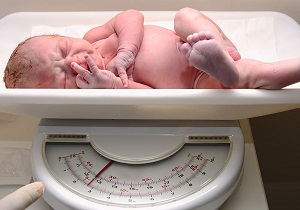
- lack of milk in a young mother. The child eats actively, but does not get enough. It is not difficult to recognize the problem: the baby suckles at the breast, then suddenly breaks away from it, tries to feed again, pulls the nipple towards itself, cries;
- low fat milk. The reason is the mother’s poor diet, poor diet, lack of high-calorie foods. The problem often arises when a woman tries to lose extra pounds, gained during pregnancy;
- dysbiosis. The newborn receives enough milk or infant formula, but the food is poorly digested if the composition of the intestinal microflora is disrupted;
- improperly organized feeding. Reasons: the baby or mother is uncomfortable, relatives are distracting, the baby is hot/cold, other family members teach what to do during feeding. Sometimes older children, out of jealousy, interfere with feeding their younger brother/sister, deliberately tug at their mother’s hands, scream, and demand attention;
- Frequent regurgitation after feeding. The baby drank enough milk or ate all the formula, but after 5–15 minutes some of the food poured back out of the ventricle. You can’t immediately put the baby in the crib; you need to carry the little one around the room in a “column”: this will release excess air;
- strict feeding regime. The mother feeds the baby strictly according to the clock and does not take into account the psychological characteristics of the baby. Tearful, weakened children do not have enough quarter of an hour to get enough: slow babies suckle for 30–40 minutes, only then do they get enough. If you stop feeding earlier, “as scheduled,” the little one will simply remain hungry;
- neurological diseases develop. Poor coordination of facial muscles and underdevelopment of certain parts of the oral apparatus negatively affect the quality of feeding. Ask for help from a pediatrician or pediatric neurologist if the newborn sucks poorly, has difficulty sucking the breast, often pulls away from the mammary glands, or cries;
- the baby is sick. One of the reasons why children drink less milk than they should. During illness, many babies lose precious grams. Some babies recover less well during teething.
On the page, read about the benefits of badger fat for children and how to take it.
What to do if your child is not gaining weight well
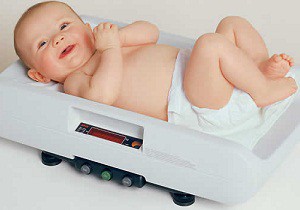
- don't panic. You can’t reproach yourself for being a “bad mother” and not feeding your baby enough. Often, panicky moods are fueled by grandmothers who think that the baby is “thin and pale.” Overweight the baby has the same serious problem as exhaustion. Focus on your little one’s well-being, consult a pediatrician, and monitor their behavior. In the first six months, the baby gains weight from 800 to 1000 g from 1 to 3 months, from 600 to 800 g from 4 to 6 months (girls - less, boys - a little more);
- Do not force feed your baby. The desire to give more milk often ends in whims, spent nerves. The baby knows how much food he needs: a hungry baby will ask for the breast earlier. With artificial feeding, excess nutritional mixture is poorly absorbed, causing digestive problems;
- Carry out an in-depth examination. Often, after undergoing tests and visiting specialists, diseases with a latent course are revealed. Neurological disorders, gastrointestinal tract defects, and jaw pathologies often cause poor milk digestibility. Only by curing the disease can weight gain be normalized;
- proper organization of feeding. A calm environment, peace of mind, sufficient rest for mommy, the absence of irritants (loud music, older children running nearby, intrusive attention from relatives) are prerequisites for proper feeding;
- choosing the appropriate mixture. Sometimes an “artificial” baby does not eat well because he does not like the taste of a certain type of baby food. Buy another formula, see how the child reacts to the new brand. Sometimes parents don't find the perfect product right away. Choose baby formulas without palm oil: high-quality products are better absorbed and are less likely to cause problems with the gastrointestinal tract;
- follow your doctor's recommendations. An experienced pediatrician is the best adviser. Many mothers forget about this rule and trust the advice of neighbors and girlfriends. Now many of the requirements and rules for caring for a newborn have changed, and the norms for weight gain for babies are slightly different from those accepted in Soviet times. Outdated information, concepts of “norm - deviations” imposed by the older generation often cause unreasonable concern among young mothers
Now you know how many grams of weight a child should gain in each month in the first year of life. Use a table that shows average numbers, focus on the baby’s behavior and activity. Remember: The weight of a newborn baby is only one indicator of the baby’s health. Deviations and norms, a table of “correct”, low, excess body weight - every young mother should study these concepts.
Video about the norm and pathology of weight and height of a newborn:



